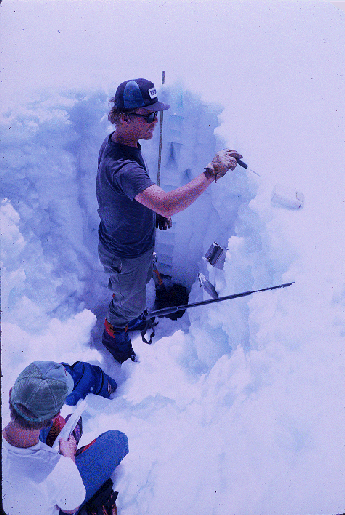 Landscapes and Water (GEOG 1011): Snow and Ice
Landscapes and Water (GEOG 1011): Snow and Ice
 Landscapes and Water (GEOG 1011): Snow and Ice
Landscapes and Water (GEOG 1011): Snow and Ice

 Sampling a snowpit, Sierra Nevada, CA.
Sampling a snowpit, Sierra Nevada, CA.
Snow on the ground is a dynamic medium. The properties and characteristics of fallen snow change constantly as a function of energy fluxes, wind, moisture, water vapor, and pressure. For example, the time window for good skiing in mid-winter may last several days after a fresh snowfall in cold continental climates. During spring conditions the time window may be only an hour or two as rock-hard boilerplate turns to ideal corn conditions before additional energy inputs turns the snowpack to unskiable slush. Physical properties of snow change over time. Furthermore, snow properties can vary widely over small distances, both vertically within a snowpack and horizontally over space.
The physical properties of snow on the ground may differ greatly from the ice crystals in the snowfall events. Ice particles that form in the atmosphere have a large variety of crystal shapes and sizes. By the time these ice crystals reach the ground, they have already undergone a number of changes resulting from growth, disintegration, or agglomeration. For example, high wind speeds near the surface may break ice crystals into smaller pieces. Further disintegration of the original snow crystals may occur as the crystals are bounced and dragged over the snow surface in the turbulent boundary layer. After being reduced in size and shaped more symmetrically through interactions with wind, the individual crystals may be packed more closely to produce a much denser surface layer than would otherwise occur.
Once ice particles are deposited in a snowpack, the shape and size of the ice grains can change dramatically by a process called snow metamorphism. Snow metamorphism is analogous to metamorphism in geology, where changes in form occur because of heat flow and pressure. A snowcover is the result of numerous snowfall events. Each of these snowfall events may occur with different meteorological conditions, resulting in a horizontally stratified snowpack that is vertically heterogeneous or anisotropic. Furthermore, meteorological conditions between snowfalls will change the physical character of the snowpack. For example, warm, sunny days may cause melt at the snow surface, producing a high-density, well-bonded layer over a colder, lower-density, and relatively poorly-bonded layer. Furthermore, ice crystals in the atmosphere are formed in a highly supersaturated, thermodynamically unstable environment. Once these ice crystals are deposited on the ground, they will change quickly to minimize their surface free-energy. Snowpack stratigraphy is the result of a combination of processes, which include: (1) individual snowfalls each with different meteorological conditions, (2) meteorological conditions between snowfall events which can form sun and wind crusts, and (3) different rates and types of grain growth after snow accumulates in the snowpack.
Snow on the ground is a complicated mixture of water in three phases: ice, liquid water, and water vapor. Moreover, air is an important component of snow on the ground, comprising 95% or more of the volume of champagne powder that is ideal for skiing. Additionally, solutes and particulates within the snowpack can influence snow properties such as the albedo of snow. Once ice crystals are deposited on the ground, we refer to them as snow grains because of the changes that occur within the snowpack. Snow grains can become bonded to their neighbors, a process called sintering. These bonded snow grains act as an ice skeleton to provide structural strength to the snowpack. As temperature within a snowpack reaches 0şC, the ice particles will begin to melt.
The best way to understand and measure snowpack properties is to dig a snowpit. A snowpit is constructed by digging a hole from the snow surface to the ground. The size of the hole is determined by (a) the number and (b) type of measurements you will make, as well as (c) the number of power bars you've consumed. Digging snow pits is hard work!
The most important tool in snow hydrology is a shovel. Generally one side of the hole is designated the working wall, where measurements of snow properties will be made. The working wall is on the side of the snowpit facing the sun, so that the wall itself faces away from direct sun and is self-shaded. After the snowpit is constructed, the working wall is smoothed by shaving back the wall with a shovel with a square blade. One drawback is that construction of a snow pit and analysis of a snow profile on the working wall takes on the order of one to two hours, depending on snow depth and hardness.
Once we've constructed our snowpit, the depth of the snowpack is an obvious parameter, easily measured by placing a measuring tape from the snow surface to the ground. We'd also like to know the amount of ice relative to air in the snowpack, or the density of the snow. Density is defined as the amount of mass per unit volume. We generally use the units of kilograms per cubic meter (kg m^3), which is 1,000, the value expressed in grams per cubic centimeter (g cm^3). The most important hydrologic parameter is the amount of liquid water stored as snow, the snow water equivalence (SWE). We can calculate SWE for some unit area as the product of snow density (rs) and depth (h), divided by the density of water (rw=1,000 kg m^3).
Champagne powder with a density near 30 kg m^3 is 97% air and only 3% ice! The densest dry snow at about 550 kg m^3 has a porosity of 40%; the ice particles are as close together as randomly packed, randomly shaped objects can be.
Often we are interested in how strong the snowpack is, from an avalanche standpoint or perhaps because we want to walk or ski on the snow surface. Hardness provides a measure of the strength of the snowpack in compression. Hardness has units of force per unit area, N m^2. Hardness generally increases with increasing density in a snowpack, and since density generally increases with depth, because of compression from the overlying snow, hardness generally increases with depth. Hardness can be measured using several types of gauges. In most field situations, hardness is estimated using a series of hand tests that involve pressing objects until the snowpack fails in compression.
The type and size of individual grains within the snowpack influences a variety of processes, including the amount and strength of bonding within the snowpack and the rate and location of meltwater flow through snow. The growth rate and grain type within a dry snowpack is driven primarily by gradients of water vapor within the snowpack. In turn, vapor pressure gradients depend on four important variables: (1) initial type of ice particle and the conditions under which it was deposited in the snowpack, (2) the temperature of the snowpack, (3) the magnitude of any temperature gradient, and (4) the size of pore spaces. Grain size and type are estimated through use of a crystal card with a millimeter grid and an 8-10x hand lens.

The temperature of the snowpack is an important variable for a variety of reasons. Temperatures within a snowpack are generally not uniform from top to bottom, which leads to gradients in the movement of water vapor through the snowpack. We'd like to know when the snowpack becomes isothermal at 0şC and meltwater is released from the bottom of the snowpack to the hydrologic system. Snowpacks are bounded by the atmosphere above and in seasonally snow-covered areas by ground below. In general, the basal layer at the bottom of the snowpack is warmed to near 0şC because of: (1) stored head in the ground from summer warming (most important), and (2) geothermal heat from the interior of the earth. The temperature of the snow surface responds to prevailing synoptic conditions as well as daytime heating and nighttime cooling (diurnal fluctuations). The combination of these boundary conditions usually results in a snow surface that is cooler than the bottom of the snowpack, producing a vertical gradient in temperature. The temperature of the snowpack can be measured using thermometers, thermisters, and thermocouples.
One of the most important characteristics of the snowpack are the size and shape of individual snow grains.
Grain shape and size tells us about the history of the snowpack at that site. Grain shape and size provide important information about snow stability and potential for avalanches to occur. There are different ideas on how to classify snow morphology. Part of the issue is the same as in biology: are you a splitter or a lumper? Perhaps the best guide is "The international classification for seasonal snow on the ground" by Colbeck and others. This report can by found at the National Snow and Ice Data Center in Boulder, CO.
There are general characteristics of snow grains that we can evaluate. What is the basic shape of the snow grains within a layer? Are they solid, hollow? Are they rounded? Do they have sharp edges? Are they faceted? Have they been broken by wind, abraded, rimed? A 10x hand lens is all you need to look at the morphology of snow grains.
Here are some examples of the most common types of snow grains.
New improvements in scanning electron microscopy (SEM) have provided the ability to make the photos above. These photos are from a trip to Niwot Ridge to collect snow samples for SEM analysis by the SEM team headed by Bill Wergin.
How big are snow grains? Most ET grains are less than 0.5 mm in diamter. In contrast, TG grains are generally larger than 3.0 mm in diameter.
Rounded snow grains that approximate the shape of spheres are characteristic of snowpacks with temperature gradients less than 10şC m^-1. Snow metamorphism is driven by gradients in vapor pressure, which in turn are driven by temperature gradients. Small temperature gradients result in small vapor pressure gradients and slow grain growth within the snowpack. The result is the formation of rounded snow grains that tend to be 0.1 to 0.2 mm in diameter. These rounded grains tend to bond together into simple chains that provide structural stability to the snowpack. The process of forming these snow grains has a number of synonyms, including the historical term of equitemperature metamorphism (ET metamorphism), equilibrium metamorphism, radius-dependent metamorphism, radius of curvature metamorphism, and destructive metamorphism. One explanation for the formation of rounded snow grains is that vapor diffusion within the snowpack causes a loss of mass from points on individual snow grains to gains in mass in hollows.
Depth hoar forms in areas of a snowpack where temperature gradients are greater than 10şC m^-1. The process of forming these snow grains has a number of synonyms, including the historical term of temperature gradient metamorphism (TG metamorphism), constructive metamorphism, and kinetic growth. The large temperature gradient induces a large gradient in vapor pressure, such that water vapor moves from warmer areas of the snowpack with relatively higher vapor pressures across pore spaces to colder areas of the snowpack with lower vapor pressure. These conditions produce angular or faceted grains, which may later develop steps and striations on their surface, resulting in cup-shaped crystals with a hollow center that generally range in size from 3-8 mm. Under very favorable conditions, individual grains can be larger than 15 mm. These large, angular grains result in poor sintering, low cohesion, and little structural strength, earning an additional synonym of sugar snow. It is almost impossible to make a snowball out of depth hoar because of the low amount of sintering. Depth hoar is often the weakest layer in the snowpack and is a potential sliding layer for avalanches.